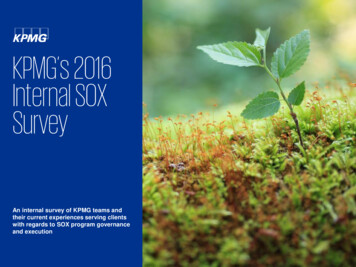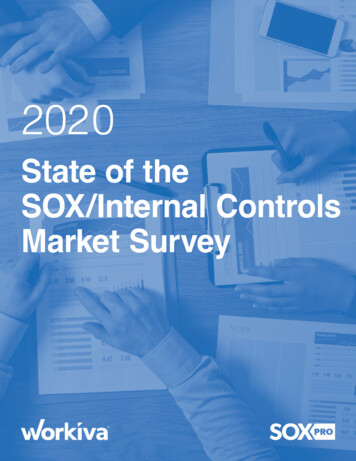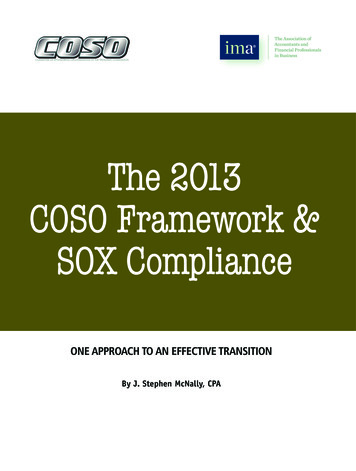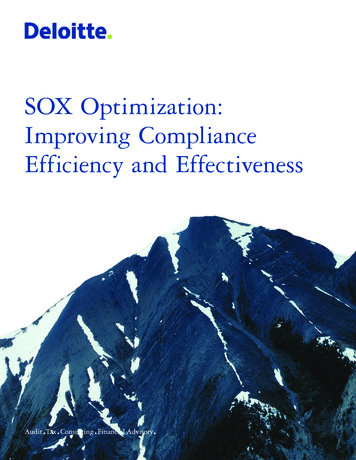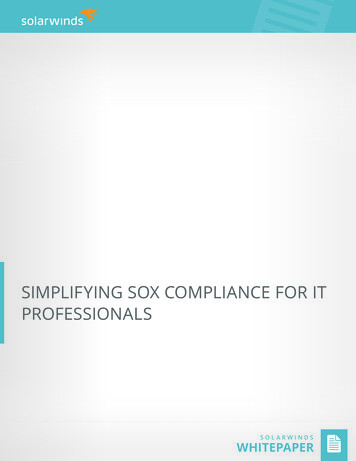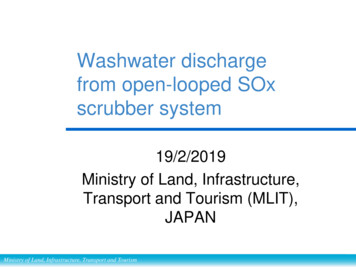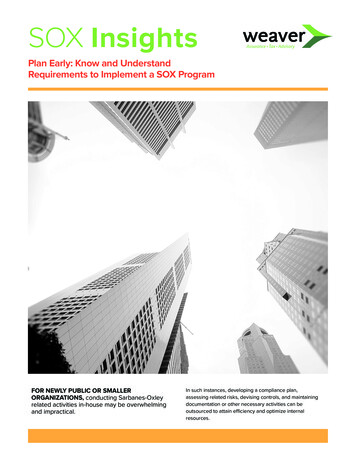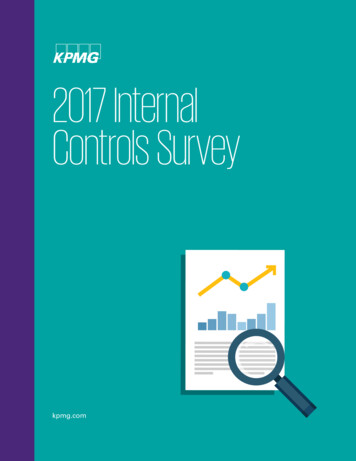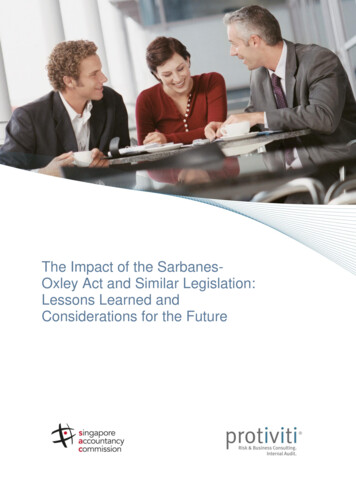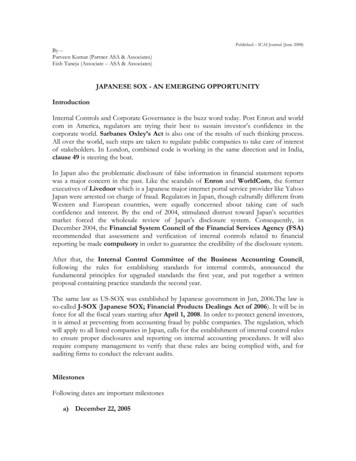
Transcription
BUSINESS OBJECTSAND SOX:9 STEPSTO COMPLIANCE
EXECUTIVE SUMMARY3WHAT IS SOX?HOW DOES SOX IMPACT BI?BUSINESS OBJECTS AND SOX 9 STEPS TO COMPLIANCE345Step 1: Back Up DataStep 2: Manage Security RightsStep 3: Find and Tag Sox InformationStep 4: Analyze and Document SOX InfoStep 5: Implement Version ControlStep 6: Find and Fix DiscrepancisStep 7: Check for Deleted ContentStep 8: Control Ungoverned ContentStep 9: Archive SOX Info6778910111213CONCLUSION14REFERENCES14
EXECUTIVE SUMMARYThe Sarbanes-Oxley Act (SOX) demands that companies establish internal controlsto protect financial data. To comply with SOX, companies must be able to locate andsafeguard financial data. Business intelligence applications expose data and thereforemust be used in a manner that supports the goals and upholds the requirements ofSOX. GB&SMITH, creator of 360Suite solutions to enhance Business Objects, developeda 9-step process to help organizations think through the challenges of SOX complianceand take appropriate action.WHAT IS SOX?SOX is shorthand for the Sarbanes-Oxley Act, which is a U.S. law that outlines auditingand financial regulations for publicly-traded companies. (Note: Some provisions applyto all enterprises, including private companies and not-for-profit organizations.) TheAct was named for its sponsors -- U.S. Sen. Paul Sarbanes (D-MD) and U.S. Rep. MichaelOxley (R-OH). It was signed into law on January 30, 2002 by President George W. Bush.SOX was enacted in response to corporate scandals in the late 1990s and early 2000s(e.g., Enron, WorldCom, Tyco, etc.). It closed loopholes in accounting practices in aneffort to improve the reliability of financial reporting and restore investor confidence.The goal of SOX is to protect shareholders, employees, and the public from accountingerrors and fraudulent financial practices.SOX requires companies to establish internal controls to prevent tampering withfinancial data. It adds a section to the United States Code stating that “any person whoattempts or conspires to commit any offense . . . shall be subject to the same penalties asthose prescribed for the offense.” It also establishes harsh criminal penalties for anyonewho is found guilty of certifying misleading or fraudulent reports. Finally, it requiresexternal auditors to express an opinion on a company’s internal control structure.3
Many other countries have regulations similar to SOX, including:Australia (Corporate Law Economic Reform Program Act aka CLERP 9)Canada (Keeping the Promise for a Strong Economy Act aka Bill 198 or CanadianSarbanes-Oxley Act or C-SOX)France (Financial Instruments and Exchange Act aka Loi de sécurité financière orLSF)Germany (Deutsche Corporate Governance Kodex and Mindestanforderungenan das Risikomanagement)India (Clause 49 of the Listing Agreement to the Indian stock exchange)Italy (Disposizioni per la tutela del risparmio e la disciplina dei mercati finanziari)Japan (Financial Instruments and Exchange Act aka J-SOX)Netherlands (code-Tabaksblat, code-Frijns, and code-Van Manen)South Africa (King Report on Corporate Governance)UK (Companies (Audit, Investigations and Community Enterprise) Act 2004)HOW DOES SOX IMPACT BI?Forrester defines Business intelligence (BI) as "a set of methodologies, processes,architectures, and technologies that transform raw data into meaningful and usefulinformation used to enable more effective strategic, tactical, and operational insightsand decision-making" (Evelson, 2008). Business intelligence applications (e.g,Business Objects, Tableau, Power BI, etc.) support this process by retrieving, analyzing,transforming, and reporting on data. It is safe to assume that all information technology,including CRM platforms, ERP systems, and BI applications contain financial dataobtained from databases. SOX comes into play when BI applications are used toprepare, share, and publish financial data.4
STEP 1: BACK UPOne way for companies to ensure the reliability of financial data is to back them upregularly. A typical Business Objects recovery strategy involves backing up the entireBusiness Objects server and CMS database. This makes it possible to restore the fullsystem, but not to perform selective rollbacks or restore individual deleted objects.Backing up the entire Business Objects server also doesn’t address the problem ofcorrupted environments (i.e., if an environment is corrupted, so too is the mirroredbackup) and won’t restore personal folders and security settings if users are accidentallydeleted.In contrast, 360Suite incremental backups allow organizations to perform full backupsas well as restore previous versions of any object in any folder at any time. Incrementalbackups are particularly important in the context of financial data for the followingreasons:1. Every time IT modifies something, it opens the door to the possibility of technicalissues, human error, or fraudulent behavior.2.Information that was not originally identified as relevant to SOX may laterbecome important due to tagging or segregation of duties (SOD).3.Incremental backups allow for business continuity in the event of a nontechnical crisis, including a natural or man-made disaster.SOX outlines rules for maintaining (aka archiving) information. Whereas archivingensures that prior year information is accessible, backups ensure that current yearinformation is accurate and complete. Both are important components of a robustinternal control policy.6
STEP 2: MANAGE SECURITY RIGHTSTo safeguard data impacted by SOX, companies must control access to them. 360Suitemakes it possible to identify, monitor, and control who has access to what informationby:Taking snapshots to track, document, and compare security over time;Providing user-centric and resource-centric views of security;Providing a patented comprehensive view of inherited rights, double-inheritedrights, and broken inheritances, to protect against a cascade effect when securityis modified;Simplifying the process of auditing, recertifying, and modifying security rights;Automating the process of administering and managing security to reducehuman error; andMaking it possible to enforce the segregation of duties (SOD) by finding, flagging,viewing, and tracking potential conflicts of interest.STEP 3: FIND AND TAG SOX INFORMATIONCompanies must identify data impacted by SOX so they can take the necessary stepsto safeguard them. 360Suite facilitates this process by making it possible to exportBusiness Objects document properties and Universe object properties (e.g., name,description, SQL statement, etc.) to Excel spreadsheets that can be shared with dataowners. Data owners can then tag SOX-related information (i.e., #SENSITIVE DATASOX) and document it in a data catalogue, taking into account that some information isimpacted by SOX only when used in combination. Tagging can also include informationabout data sensitivity, life cycle, SOD, etc. Once tagging is complete, 360Suite canimport tags back into Business Objects to update documents and Universe objectdescriptions.Learn how to tag SOX-related information in SAP BusinessObjects.7
STEP 4: ANALYZE AND DOCUMENT SOX INFOTags make it easy to monitor actions on SOX data and spot unusual behavior. Companiesshould analyze and document the following in order to answer the questions: What?Why? When? By whom?Security changesType of action/inaction on SOX dataNumber of actions on SOX dataNumber and format of exports and schedules of SOX dataData report sourcesCreation of new content based on SOX dataBusiness Objects has powerful auditing capabilities, but can be subject to performancedegradation over time. For example, Business Objects systems with a high rate ofutilization can become bloated if they track every possible auditable event, write eventsto text files before they are loaded into the audit database, and retain audit data forlong periods of time. This is why many organizations opt to purge Business Objectsdata after one year.Another problem is that Business Objects can audit actions, but not inactions.Sometimes what wasn’t done to SOX data is just as significant as what was done tothem. Also, when organizations migrate Business Objects (e.g., from 4.1 to 4.2), theschema changes so they start a new Audit database. Since most companies migrateBusiness Objects every three or four years, their audit history is rarely longer than that.In contrast, 360Suite captures regular snapshots of metadata extracted from theCMS database, the Audit database, and the Input and Output Filestores. This makes ispossible to display the activity of specific users on specific objects. And because theinformation is stored in an offline data mart specifically designed for BI-on-BI reporting,it doesn’t put a load on Business Objects during peak times.8
STEP 5: IMPLEMENT VERSION CONTROLVersion control refers to a system that records changes to a file or set of files over time,and makes it possible to recall specific versions. In the context of SOX, version controlensures the transparency and traceability of financial data and is an important part ofan adequate internal control structure.360Suite makes it possible to understand who made changes -- when, why, and how-- and who approved the changes. 360Suite features that contribute to version controlinclude:A check-out/check-in process for documents, Universes, and connections;“Secured check-out,” which ensures that only the user who checked out an objectcan edit it (except the Administrator), until the object is checked back in;The ability to require users to include a comment explaining changes at check-in;A workflow approval process that requires changes to be approved beforepublication;The ability to compare document versions and record changes over time; andThe ability to compare Universes and record changes over time.9
STEP 6: FIND AND FIX DISCREPANCIESBecause the intent of SOX is to improve the accuracy and reliability of corporatedisclosures, and because SOX grants issuers the opportunity to cure any defects,companies must devise a strategy to find and fix discrepancies in SOX data.Discrepancies can appear in documents, metadata, variables, and/or security.One way to identify discrepancies is through regression testing, which is an importantquality assurance practice following upgrades, changes, and migrations. Regressiontesting is often performed only at the database level, but this approach has the potentialto overlook regressions in documents published by business intelligence applications.360Suite can perform regression testing at the document level. It can also search forregressions in images (e.g., graphs, charts) at the pixel level, which is particularly usefulfor highly formatted documents. 360Suite can even identify regressions in metadatafrom the CMS and FileStore. And it can test for variable discrepancies caused bycalculation engine changes, determine if the variables are used in other documents,and push bulk fixes.Another important quality assurance practice is regular user account recertification toreflect changes to staff and job functions. 360Suite facilitates this practice by trackingand documenting security over time, and identifying security discrepancies. This is anextension of Step 2 (Manage Security Rights), because controlling who has access toSOX data is not a one-off activity.360Suite automates manual processes, like regression testing, that are time consumingand prone to human error. By scheduling regression testing using the latest values andhighlighting differences, 360Suite helps companies find and fix discrepancies in SOXdata before they cause lasting damage.10
STEP 7: CHECK FOR DELETED CONTENTSOX makes it a crime to knowingly alter, destroy, mutilate, conceal, cover up, or falsifydocuments. That’s why companies should keep track of all “delete” actions.Sometimes content is intentionally deleted for valid reasons. For example, employeesmay duplicate documents, customize them, and then delete one or more versions.Other times, content is accidentally deleted as a result of IT issues, human error, orfraudulent behavior.Business intelligence applications, like Business Objects, treat deletions as auditableevents and record them. 360Suite accesses these audit records and combines themwith information from the CMS and FileStore to generate a list of all actions (e.g., delete,copy, save to, etc.) linked to specific users. Because 360Suite back ups are incremental(see Step 1), companies have the ability to restore suspiciously deleted content (e.g.,users, inboxes, access control levels, etc.) at the object level. 360Suite also goes beyondthe Business Objects recycle bin by making it possible to restore inboxes, includingpersonal folders and security settings, if users are accidentally deleted.11
STEP 8: CONTROL UNGOVERNED CONTENTDespite their popularity, business intelligence applications haven’t entirely replacedungoverned end-user computing (EUC) applications (e.g., Excel). It’s not uncommon tosee data from business intelligence reporting (e.g., Webi) exported to Excel and thenused as the basis for SOX reporting.Ungoverned content is problematic because:Data sources can’t be controlled;The information is easy to share;The information is easy to alter, including for fraudulent purposes;The information is hard to track; andThe information is subject to regressions when converted from the originalformat.Ideally, companies should take steps to prevent ungoverned content. At a minimum,they should take steps to control it. 360Suite makes it possible to password-protect.pdf, .xls and .zip instances from Business Objects. This limits unwanted sharing andminimizes security issues, but doesn’t necessarily prevent fraudulent behavior. 360Suitecan also watermark .pdf and .xls documents. Finally, 360Suite can perform regressiontesting on Webi report sources before data are exported to Excel to ensure consistency.12
STEP 9: ARCHIVE SOX INFOSOX requires companies to establish internal control structures and procedures thatinclude maintaining records. In addition, SOX requires registered public accountingfirms to maintain audit-related information for at least seven years. When archivinginformation, companies need to consider whether or not a particular format is likely tobe retrievable seven or more years into the future.360Suite supports automatically archiving and pseudo-archiving SOX content based onpredetermined values (e.g., fiscal year) in common format standards. For the purposesof this paper, archiving refers to storing information outside of Business Objects, andpseudo-archiving refers to storing information within a Business Objects environment.In both cases, it’s important to consider restoration scenarios and security aspects.There are six ways to archive/pseudo-archive with 360Suite:1.Take Webi (.wid) .pdf, .xls, .txt, and .csv instances of Business Objects documentsand save them to a file system outside of Business Objects. (Note: Archiving a.wid requires access to the Web Intelligence Rich Client in order to open it.)2.Flag unused content with #TOARCHIVE and automatically promote it to a folderon the current or another BIP environment.3.Back up all content and delete unused content from the BI Platform, with theoption to restore individual items, if required.4.Pseudo-archive dynamically when triggered by Business Objects events, andburst instances to an external network location for record-keeping.5.Pseudo-archive via security, so content remains within Business Objects, but ishidden from users via custom access level rights.6.Pseudo-archive via security, so content remains within Business Objects butis stored in restricted folders. (Note: Only the Administrator can restore contentto its original folder.)If desired as part of internal control procedures, 360Suite can archive information toa “Write Once, Read Many” (WORM) device, from which information can be retrieved,but neither modified nor deleted.13
CONCLUSIONComplying with SOX has a lot in common with complying with other regulatoryrequirements (e.g., GDPR, HIPAA, FISMA, etc.). But there are also important distinctions.For example, GDPR requires organizations to delete personal data in many situations,while SOX regulations require organizations to save financial data and be able tosubstantiate all deletions.GDPR: Governs the processing and free movement of personal dataHIPAA: Regulates access to health informationFISMA: Requires federal agencies to implement an information security programSOX: Requires companies to establish internal controls to prevent tamperingwith financial dataIn every case, organizations must understand what information is subject to regulations,be able to find and monitor that information, and safeguard the information bycontrolling access to it, ensuring accuracy, and creating backups. 360Suite achievesall these goals with unique and powerful solutions that run behind the scenes tohelp companies comply with SOX and other regulations in the context of businessintelligence applications.REFERENCESSarbanes-Oxley Act of 2002.Evelson, B. (2008). Topic Overview: Business Intelligence.REQUEST A DEMOAuthor: Bruno MasekKristen Champagne Gray14
BUSINESS OBJECTSAND SOX:9 STEPSTO COMPLIANCEVisit https://360suite.io
SOX. GB&SMITH, creator of 360Suite solutions to enhance Business Objects, developed a 9-step process to help organizations think through the challenges of SOX compliance and take appropriate action. WHAT IS SOX? SOX is shorthand for the Sarbanes-Oxley Act, which is a U.S. law that outlines auditing
